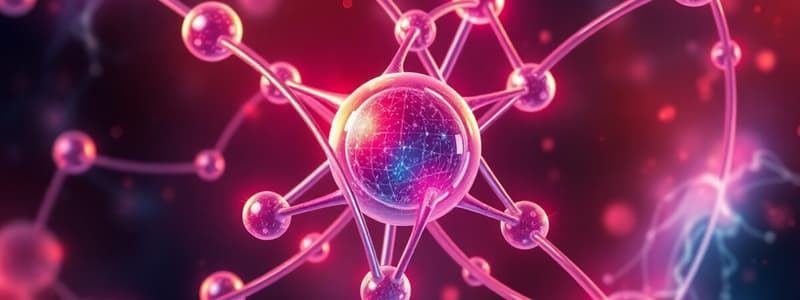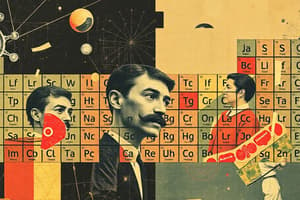Podcast
Questions and Answers
How did Rutherford's model refine previous atomic models?
How did Rutherford's model refine previous atomic models?
- It proposed that electrons are distributed throughout the atom in a 'plum pudding' structure.
- It described the atom as an indivisible and indestructible entity.
- It introduced the concept of electrons existing in fixed orbits around the nucleus.
- It established the existence of a small, dense nucleus containing positively charged particles (protons). (correct)
Which principle did Werner Heisenberg formulate regarding the position and velocity of an electron?
Which principle did Werner Heisenberg formulate regarding the position and velocity of an electron?
- The aufbau principle, dictating the order in which electrons fill atomic orbitals.
- The uncertainty principle, asserting that the position and velocity of an electron cannot both be precisely known simultaneously. (correct)
- Hund's rule, stating that electrons will individually occupy each orbital within a subshell before doubling up in any one orbital.
- The Pauli exclusion principle, stating that no two electrons can have the same set of quantum numbers.
Which quantum number defines the shape of an electron's orbital?
Which quantum number defines the shape of an electron's orbital?
- Principal quantum number (n).
- Azimuthal quantum number (l). (correct)
- Spin quantum number (ms).
- Magnetic quantum number (ml).
What does the magnetic quantum number ($m_l$) specify regarding an electron's orbital?
What does the magnetic quantum number ($m_l$) specify regarding an electron's orbital?
What distinguishes a molecule from a compound?
What distinguishes a molecule from a compound?
In the context of valence electrons and periodic table groups, what is a key difference between Group 1 (alkali metals) and Group 2 (alkaline earth metals)?
In the context of valence electrons and periodic table groups, what is a key difference between Group 1 (alkali metals) and Group 2 (alkaline earth metals)?
How does electronegativity influence the formation of a covalent bond?
How does electronegativity influence the formation of a covalent bond?
Considering a scenario where a doctor uses different compounds to treat a patient, what property of NaCl (salt) makes it suitable for dissolving easily in water in a saline solution?
Considering a scenario where a doctor uses different compounds to treat a patient, what property of NaCl (salt) makes it suitable for dissolving easily in water in a saline solution?
Considering the relationship between the periodic table and electron configuration, how would you determine the number of valence electrons for an element?
Considering the relationship between the periodic table and electron configuration, how would you determine the number of valence electrons for an element?
If Aluminum (Al) loses three electrons to form $Al^{+3}$, how many electrons does the aluminum ion then possess?
If Aluminum (Al) loses three electrons to form $Al^{+3}$, how many electrons does the aluminum ion then possess?
Considering molecular oxygen ($O_2$) is a gas at room temperature, which statement gives the most accurate reason for this?
Considering molecular oxygen ($O_2$) is a gas at room temperature, which statement gives the most accurate reason for this?
Why is metallic copper (Cu) used in medical instruments, relating to the nature of its bonding?
Why is metallic copper (Cu) used in medical instruments, relating to the nature of its bonding?
Given oxygen (O), what does its position in the periodic table tell us about its reactivity?
Given oxygen (O), what does its position in the periodic table tell us about its reactivity?
What quantum number is most closely associated with the energy level of an electron?
What quantum number is most closely associated with the energy level of an electron?
Which of the following best describes the key difference between ionic and covalent bonds?
Which of the following best describes the key difference between ionic and covalent bonds?
What is the significance of valence electrons in the formation of chemical bonds?
What is the significance of valence electrons in the formation of chemical bonds?
Which kind of bond is formed between two oxygen atoms ($O_2$)?
Which kind of bond is formed between two oxygen atoms ($O_2$)?
Compared to covalent bonds, what defines a metallic bond?
Compared to covalent bonds, what defines a metallic bond?
What distinguishes an anion from a cation?
What distinguishes an anion from a cation?
What is the importance of James Chadwick's discovery of the neutron?
What is the importance of James Chadwick's discovery of the neutron?
Which statement accurately describes the difference between a polar and a nonpolar covalent bond?
Which statement accurately describes the difference between a polar and a nonpolar covalent bond?
Unlike ionic and covalent bonds, what unique characteristic defines metallic bonding?
Unlike ionic and covalent bonds, what unique characteristic defines metallic bonding?
Relating to atomic properties, what primarily determines an atom’s chemical behavior?
Relating to atomic properties, what primarily determines an atom’s chemical behavior?
What significance do 'periods' in the periodic table have related to electron configuration?
What significance do 'periods' in the periodic table have related to electron configuration?
In terms of electron configuration, what makes noble gases (Group 18) relatively unreactive?
In terms of electron configuration, what makes noble gases (Group 18) relatively unreactive?
If one element has a high electronegativity and another has a low electronegativity, what kind of bond will likely form between them?
If one element has a high electronegativity and another has a low electronegativity, what kind of bond will likely form between them?
Glucose ($C_6H_{12}O_6$) is soluble in water but doesn't conduct electricity when dissolved. What does this indicate about the type of bonds in glucose?
Glucose ($C_6H_{12}O_6$) is soluble in water but doesn't conduct electricity when dissolved. What does this indicate about the type of bonds in glucose?
What principle dictates the order in which electrons fill atomic orbitals?
What principle dictates the order in which electrons fill atomic orbitals?
What does the Pauli exclusion principle state?
What does the Pauli exclusion principle state?
Flashcards
¿Qué es un átomo?
¿Qué es un átomo?
The smallest unit of matter that retains the chemical properties of an element.
¿Qué es un Ión?
¿Qué es un Ión?
An atom that has gained or lost electrons, giving it an electrical charge.
¿Qué es un elemento?
¿Qué es un elemento?
A substance consisting of only one type of atom. Cannot be broken down into simpler substances by chemical means.
¿Qué es una molécula?
¿Qué es una molécula?
Signup and view all the flashcards
¿Qué es un compuesto?
¿Qué es un compuesto?
Signup and view all the flashcards
¿Qué es el número atómico?
¿Qué es el número atómico?
Signup and view all the flashcards
¿Qué es el número másico?
¿Qué es el número másico?
Signup and view all the flashcards
¿Qué es la configuración electrónica?
¿Qué es la configuración electrónica?
Signup and view all the flashcards
¿Qué es un orbital?
¿Qué es un orbital?
Signup and view all the flashcards
¿Qué describe el número cuántico principal (n)?
¿Qué describe el número cuántico principal (n)?
Signup and view all the flashcards
¿Qué describe el número cuántico azimutal (l)?
¿Qué describe el número cuántico azimutal (l)?
Signup and view all the flashcards
¿Qué describe el número cuántico magnético (ml)?
¿Qué describe el número cuántico magnético (ml)?
Signup and view all the flashcards
¿Qué describe el número cuántico de espín (ms)?
¿Qué describe el número cuántico de espín (ms)?
Signup and view all the flashcards
¿Qué es un enlace químico?
¿Qué es un enlace químico?
Signup and view all the flashcards
¿Qué es un enlace iónico?
¿Qué es un enlace iónico?
Signup and view all the flashcards
¿Qué es un enlace covalente?
¿Qué es un enlace covalente?
Signup and view all the flashcards
¿Qué es un enlace metálico?
¿Qué es un enlace metálico?
Signup and view all the flashcards
¿Qué es la Electronegatividad?
¿Qué es la Electronegatividad?
Signup and view all the flashcards
¿Qué es la tabla periódica?
¿Qué es la tabla periódica?
Signup and view all the flashcards
¿Qué son los grupos en la tabla periódica?
¿Qué son los grupos en la tabla periódica?
Signup and view all the flashcards
¿Qué son los periodos en la tabla periódica?
¿Qué son los periodos en la tabla periódica?
Signup and view all the flashcards
Study Notes
- The objectives of this lesson include understanding atomic structure and the differences between atoms, ions, molecules, compounds, and elements, and to also identify the organization of the periodic table and its relationship to valence and chemical bonds.
Atomic Structure
- The components of atomic structure include:
- Protons which have a positive charge
- Neutrons which have a neutral charge
- Electrons which have a negative charge
Atomic Theory
- John Dalton in 1803 proposed that matter has indivisible and indestructible atoms.
- J.J. Thomson in 1904 discovered the electron with the plum pudding model.
- Ernest Rutherford in 1911 discovered the small, dense nucleus, containing positively charged protons in his planetary model.
- Niels Bohr in 1913 suggested that electrons move in fixed energy levels, orbiting around the nucleus in fixed orbits.
- Erwin Schrödinger in 1926 described electrons as waves in orbitals, rather than fixed orbits, using the quantum mechanical model.
- James Chadwick in 1932 discovered neutrons, which stabilize the nucleus.
- Werner Heisenberg in 1927 formulated the uncertainty principle, which states that the position and velocity of an electron cannot be precisely known simultaneously.
Electronic Configuration
- Electronic configuration describes how electrons are distributed in the different levels and orbitals within an atom.
Quantum Numbers
- Principal quantum number (n) describes the energy level of an electron.
- Uses positive integers like: n=1,2,3,4
- Oxygen's (O) outermost electron: n=2n because it’s in the second energy level.
- Azimuthal quantum number (l) specifies the type of orbital where an electron is found.
- Values: l=0 (s), l=1 (p), l=2 (d), l=3 (f)
- Oxygen's (O) outermost electron: l=1, being in a p orbital.
- Magnetic quantum number (ml) dictates the orientation of an orbital in space.
- Values range from -l to +l
- Oxygen's (O) outermost electron: ml=-1.
- Spin quantum number (ms) indicates the direction of electron spin within the orbital.
- Options: ms=+1/2 or -1/2
- Oxygen's (O) outermost electron: ms = -1/2.
Calculating Quantum Numbers for Sodium Example
- Determining the electronic configuration for sodium, which has 11 electrons:1s² 2s² 2p⁶ 3s¹
- Identifying the quantum numbers for Na:
- n=3
- l=0
- m=0
- s= +1/2
Atoms, Ions, Elements, Molecules and Compounds
- An atom is the smallest unit of matter.
- Example: hydrogen (H), and oxygen (O).
- An ion is an atom with an electrical charge because of lost or gained electrons.
- Example: Sodium cation (Na+), a sodium atom has lost an electron or Chloride anion (Cl-), a chloride atom that has gained an electron.
- An element is composed of the same type of atoms and it can not be broken down.
- Example: Iron (Fe), gold (Au) and carbon (C).
- A molecule is a unit of two or more atoms, that are the same or different.
- Example: Water (H2O), comprised of hydrogen and oxygen atoms.
- A compound is a pure chemical substance made of two or more different elements chemically bonded in fixed proportions.
- Example: Carbon dioxide (CO2), composed of carbon and oxygen.
Periodic Table
- Groups (Vertical Columns 1, 2, and 13-18): elements with similar properties caused by the number of valence electrons that they share.
- Group 1 (Alkali Metals): highly reactive, with 1 valence electron.
- Group 2 (Alkaline Earth Metals): reactive, with 2 valence electrons.
- Group 13 (Boron Group): 3 valence electrons.
- Group 14 (Carbon Group): 4 valence electrons.
- Group 15 (Pnictogens): 5 valence electrons.
- Group 16 (Chalcogens): 6 valence electrons.
- Group 17 (Halogens): highly reactive, with 7 valence electrons.
- Group 18 (Noble Gases): non-reactive, with fully occupied valence shells.
- Periods (Horizontal Rows) indicate the number of energy levels (n) in an atom's electron configuration, however, there are varying numbers of electrons in the outermost shells.
Chemical Bonding
- The force that holds two or more atoms together and make them function as a unit.
- Measured through bond energy and indicates the energy amount needed to break the bond.
- Valence electrons form chemical bonds.
Types of bonds
- Ionic bonds forms when a (Metal) cedes an electron.
- Atoms that have high affinity to electrons.
- Composed of METAL + NON METAL
- Metallic Bonds are produced by the conjunction of linked metals, resulting in a dense cloud of electrons.
- Covalent Bonds forms between Non Metallic atoms that share electrons.
- Composed of NO METAL + NO METAL
- Polar covalent bonds are made of different elements.
- Apolar covalent bonds are made of elements of the same kind.
Electronegativity and Polar Covalent Bonds
- Electronegativity is the capacity for an atom to attract electrons.
- The polarity of the covalent bond is dependent on the differences in electronegativity between the atoms that make up the bond.
Medical Context
- Sodium chloride (NaCl) is a saline solution used to rehydrate patients.
- Glucose (C6H12O6) provides energy.
- Molecular oxygen (O2) is used by mask to improve blood oxygenation.
- Ferrous sulfate (FeSO4) is an iron supplement to treat existing anemia.
- Metallic copper (Cu) is to make medical instruments.
Studying That Suits You
Use AI to generate personalized quizzes and flashcards to suit your learning preferences.




